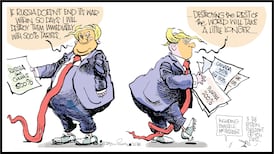We’d like to welcome you on board the 5.35pm train from Dublin to Waterford. Please do not occupy pre-booked seats. No, we’re not going to tell you which ones those are. The seat booking system is malfunctioning again, so you’ll just have to work it out for yourselves.
Those of us who travel this line regularly are untroubled: with a booking system as unpredictable as the moods of Logan Roy, we have made note of which seats are always kept open. So we nab one and leave less practised passengers and hapless tourists to battle it out for the rest in a terse version of musical chairs. Meanwhile, the train is conducting an experiment on the extreme effects of climate: one carriage is heated to Death Valley temperatures; the next is like the Arctic Circle. News of the much-vaunted return of the trolley snack tray has not yet reached this line, so unless you brought your own bottle of water, you’re goosed. And that’s even before you disembark and faff about with coins for Dublin Bus, or take your chances with compression asphyxia on a rush-hour Luas.
As a long-distance rail commuter, I was not shocked to learn that Dublin was recently ranked worst for public transport in a survey of 30 European capitals by Greenpeace. The Greenpeace survey looked at only two factors – how affordable tickets are and how easy it is purchase to long-term tickets. Overall, Ireland ranked 13th, its position bolstered by the free travel for the over-65s and a zero VAT rate on tickets. But Dublin came last among European cities, scoring 36 out of 100 points in the rankings. It was the only city analysed by Greenpeace “which does not have a fixed-price long-term ticket for all means of transport and available for all passengers.” Not un-coincidentally, a 16 month study by Dublin City Council and Project Street View on air pollution found elevated levels of nitrogen dioxide – which is associated with transport emissions – on the big approach roads into the city and along the Liffey quays.
Irish people often say they love their cars. In reality, what they mean is that they would sooner sit in traffic than sharpen their elbows and squeeze on to a crowded tram. Ireland’s public transport system is not unrelentingly awful. The 2022 National Transport Authority Customer Satisfaction Report found that 44 per cent of people were “fairly satisfied” with the public transport network, and 38 per cent of people were very satisfied. That’s somewhere between a “meh” and a “pretty okay”. But it could be so much better.
READ MORE
Irish Times readers have been responding to the Greenpeace survey by pointing out the many other ways in which public transport in this country could be improved. Perhaps surprisingly, not much of it was actually about price. A lot of the comments boiled down to boring and obvious innovations such as allowing bus passengers who don’t have a Leap card to pay by card, instead of making them carry coins. Or having buses that operate according to some sort of predictable schedule. Or acknowledging that not every journey begins and ends in Dublin. Or laying on intercity services that work around the average working day. Incredibly, the last train from Dublin to Waterford departs at 6.35pm.
Building a public transport network is hard. But once you have already made the investment in infrastructure, having it run efficiently and making passengers feel good about using it really shouldn’t be. And in the face of a climate emergency, it can’t afford to be.
If you’ve got the infrastructure in place, the rest – as advertising guru Rory Sutherland has noted – is about small, contextual changes that give the illusion of an efficient and functioning system. His description of how consumers make judgments about the quality of air travel could apply to all forms of public transport: “Ninety per cent of people have no idea what sort of aircraft they are travelling on or how a jet engine works, but will infer a great deal about the safety and quality of the experience offered by an airline from the care and attention it pays to on-board snacks.” In the case of trains, for “snacks on planes” you can substitute a working seat booking system, consistent wifi and not waiting until 10 minutes before departure to announce which platform a train is leaving from. Seamless ticketing, highlighted in the Greenpeace survey, is another example, making passengers feel that someone is thinking through their journey needs.
None of this is rocket science. But Irish public transport is another symptom of how, in this country, we are experts at making easy things hard.
We have put all our focus on the introduction of electric cars, despite live questions about how efficient and practical they actually are for many people: questions like whether there are enough charging points or what happens when your battery depletes or how people who live in apartments or city streets are supposed to charge their cars. But getting drivers to swap from diesel or petrol cars into electric ones is just rearranging the deck chairs on the Titanic.
What we need to aim for is the elimination of the need for anyone to take a car into the city. Part of this involves making cities unwieldy and expensive to navigate. But there has to be a carrot, too. The goal shouldn’t just be that there’s no need for anyone working in Dublin – or any other city – to travel there by car, but that the alternatives are so good, no one wants to. Achieving that will require making public transport that is more affordable, and not an exercise in endurance.
















